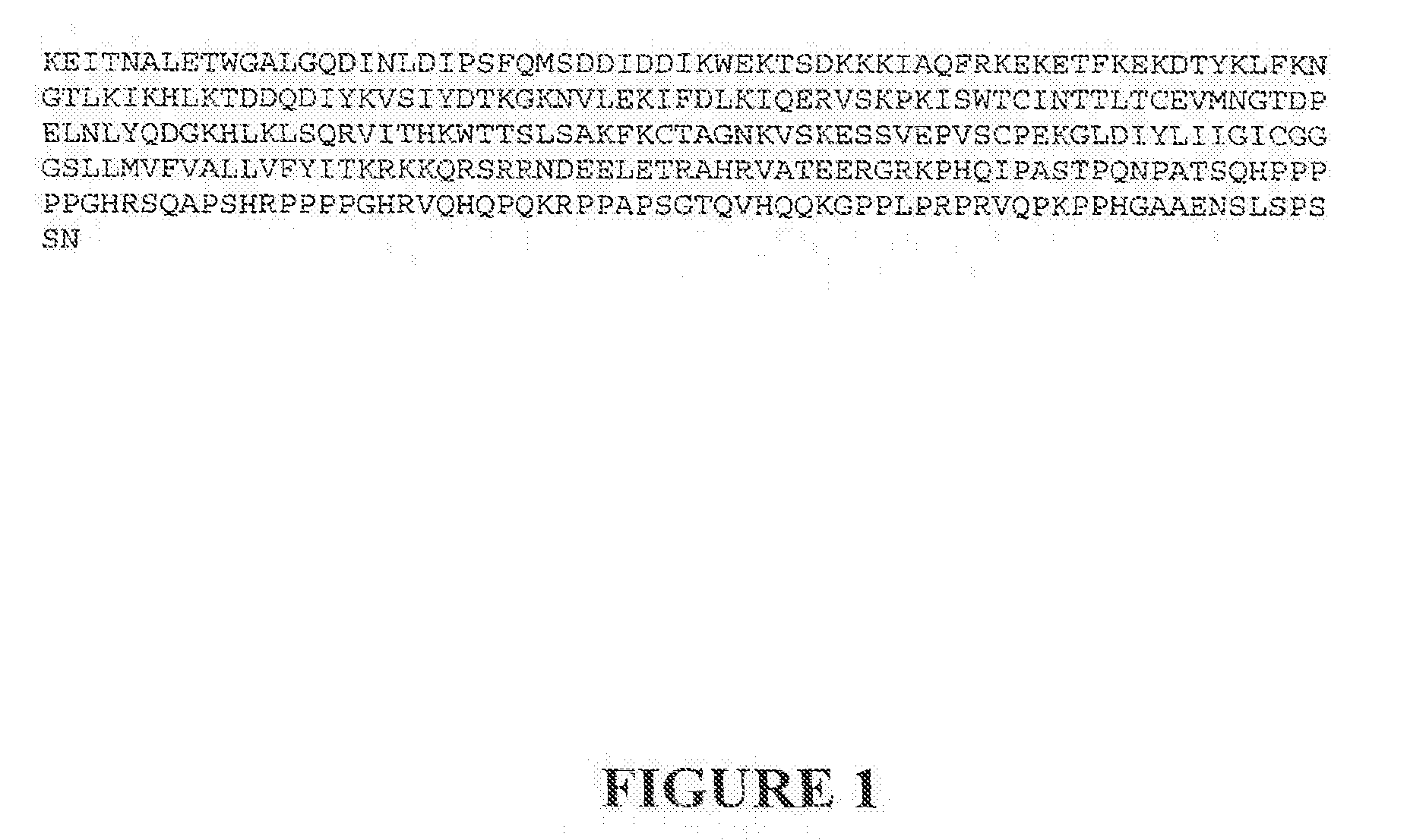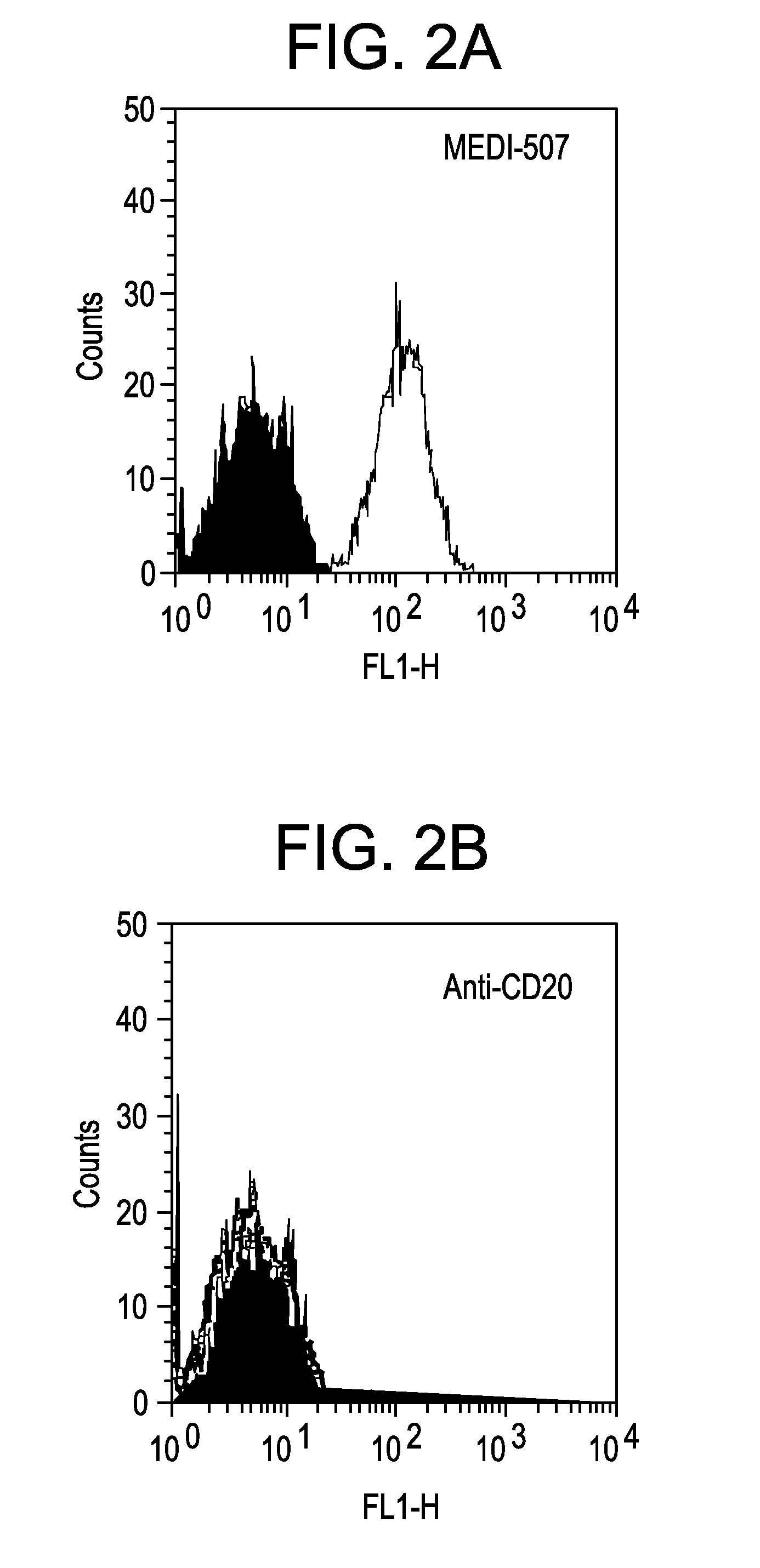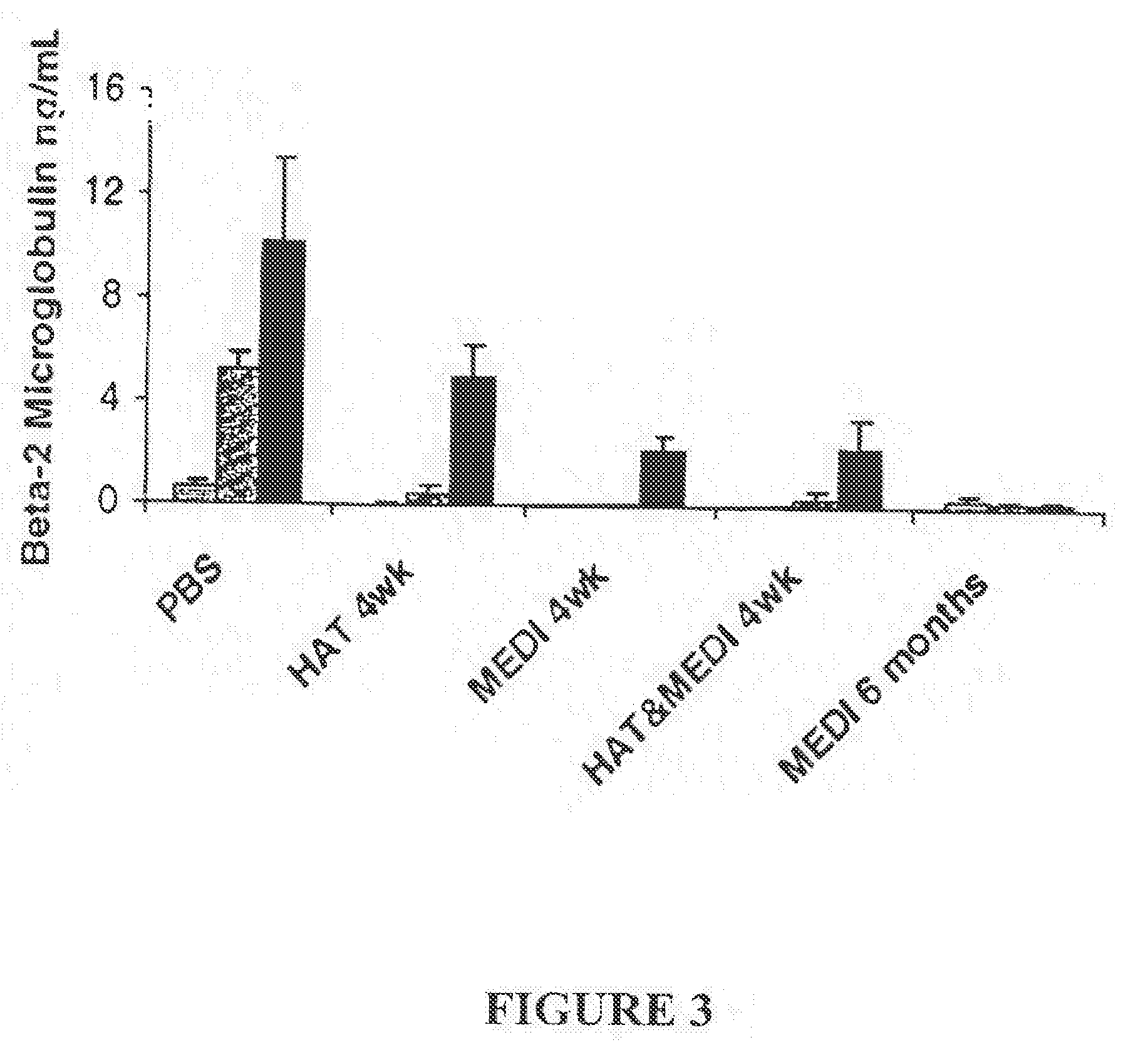[0025]In one embodiment, the use of MEDI-507, an analog, derivative or an antigen-binding fragment thereof enhances the efficacy of standard or experimental treatment regimens for cancer. In a preferred embodiment, the use of MEDI-507, an analog, derivative or an antigen-binding fragment thereof enhances the efficacy of standard or experimental treatment regimens for T-cell malignancies (e.g., chemotherapy, radioimmunotherapy, or radiotherapy). In another embodiment, the use of MEDI-507, an analog, derivative or an antigen-binding fragment thereof prolongs the survival of a subject diagnosed with a T-cell malignancy.
[0026]The invention encompasses the use of MEDI-507, an analog, derivative, or an antigen-binding fragment thereof in combination with a standard or experimental cancer therapy for the prevention, treatment or amelioration of cancer, particularly a T-cell malignancy, or one or more symptoms thereof. The invention provides methods for preventing, treating, managing, or ameliorating cancer, particularly a T-cell malignancy, or one or more symptoms thereof, said methods comprising administering to a subject in need thereof a prophylactically or therapeutically effective amount of MEDI-507, an analog, derivative, or an antigen-binding fragment thereof, and one or more prophylactic or therapeutic agents, preferably prophylactic or therapeutic agents other than CD2 antagonists, which are currently being used, or have been used or are known to be useful in the prevention, treatment, management, or amelioration of cancer, particularly a T-cell malignancy, or one or more symptoms thereof. The invention also provides methods for preventing, treating, managing, or ameliorating cancer, particularly a T-cell malignancy, or one or more symptoms thereof, said methods comprising administering to a subject in need thereof a prophylactically or therapeutically effective amount of MEDI-507, an analog, derivative, or an antigen-binding fragment thereof conjugated to a therapeutic agent or drug, and one or more prophylactic or therapeutic agents, preferably prophylactic or therapeutic agents, other than CD2 antagonists, which are currently being used or have been used or are known to be useful for in the prevention, treatment, management, or amelioration of cancer, particularly a T-cell malignancy, or one or more symptoms thereof. Examples of therapeutic agents that can be used in combination with MEDI-507, an analog, derivative, or an antigen-binding fragment thereof for the prevention, treatment, management, or amelioration of cancer, include but are not limited to, chemotherapeutic agents, therapeutic antibodies, and angiogenesis inhibitors. Examples of therapeutic agents that are particularly useful in combination with MEDI-507, an analog, derivative, or an antigen-binding fragment thereof, for the prevention, treatment, management, or amelioration of T-cell malignancies, include but are not limited to, Campath®, anti-Tac, purine analogs, pentostatin, cytotoxic agents, anti-retroviral agents, arsenic trioxide, interferon-alpha, and anti-cancer agents. Chemotherapeutic agents that can be used in combination with MEDI-507, an analog, derivative, or an antigen-binding fragment thereof include but are not limited to alkylating agents, antimetabolites, natural products, and hormones. The combination therapies of the invention enable lower dosages of MEDI-507, an analog, derivative or an antigen-binding fragment thereof and / or less frequent administration of MEDI-507, an analog, derivative or an antigen-binding fragment thereof to a subject with cancer, particularly a T-cell malignancy, to achieve a therapeutic or prophylactic effect.
[0046]As used herein, the term “effective amount” refers to the amount of a therapy which is sufficient to reduce or ameliorate the severity and / or duration of cancer, (particularly a T-cell malignancy) or one or more symptoms thereof, prevent the advancement of cancer (particularly a T-cell malignancy) or one or more symptoms thereof, cause regression of cancer (particularly a T-cell malignancy) or one or more symptoms thereof, or enhance or improve the prophylactic or the therapeutic effect(s) of another therapy (e.g., a prophylactic of therapeutic agent).
[0069]As used herein, the term “synergistic” refers to a combination of therapies (e.g., combination of prophylactic and / or therapeutic agents) which is more effective than the additive effects of any two or more single therapies (e.g., two or more single prophylactic or therapeutic agents). A synergistic effect of a combination of therapies (e.g., prophylactic or therapeutic agents) permits the use of lower dosages of one or more of the therapies (e.g., one or more prophylactic and / or therapeutic agents) and / or less frequent administration of said therapies to a subject with cancer, particularly a T-cell malignancy. The ability to utilize lower dosages of therapies (e.g., prophylactic and / or therapeutic agents) and / or to administer said therapies less frequently reduces the toxicity associated with the administration of said therapies to a subject without reducing the efficacy of said therapies in the prevention, treatment, management, or amelioration of cancer, particularly a T-cell malignancy, or one or more symptoms thereof. In addition, a synergistic effect can result in improved efficacy of therapies (e.g., prophylactic and / or therapeutic agents) in the prevention, treatment, management, or amelioration of cancer, particularly a T-cell malignancy, or one or more symptoms thereof. Finally, synergistic effect of a combination of therapies (e.g., prophylactic and / or therapeutic agents) may avoid or reduce adverse or unwanted side effects associated with the use of any single therapy.
[0072]As used herein, the term “therapeutically effective amount” refers to that amount of a therapy (e.g., a prophylactic or therapeutic agent) which is sufficient to reduce the severity of cancer (particularly, a T-cell malignancy), reduce the duration of cancer (particularly, a T-cell malignancy), ameliorate one or more symptoms of cancer (particularly, a T-cell malignancy), prevent or slow the advancement of cancer (particularly, a T-cell malignancy), cause regression of cancer (particularly, a T-cell malignancy), or enhance or improve the therapeutic effect(s) of another therapy (e.g., a prophylactic or therapeutic agent).
 Login to View More
Login to View More 


